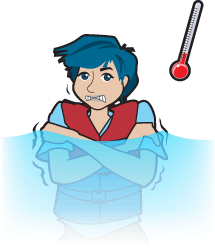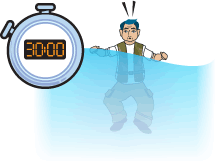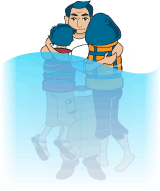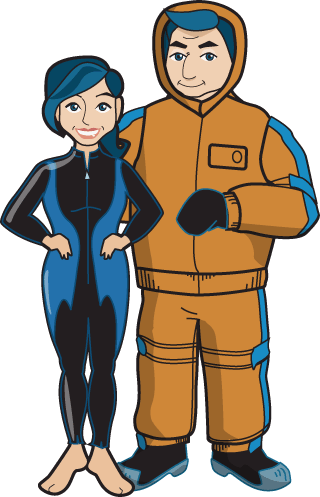Cold Water Immersion: Stages and Survival Tips for Boating
Every year, many drowning and boat related fatalities are the direct result of a fall overboard or a boat capsizing in cold water.
Why is cold water immersion so dangerous? Because cold water literally "shocks" the body and causes it to slowly shut down, making drowning much more likely.
As a boater, you want to avoid cold water whenever possible and take extra caution whenever boating in cold water environments.
You also need to know some survival tips in the event of an emergency situation where you do end up in cold water. We'll review these tips, as well as the stages of cold water immersion, in more detail in next.
For now, remember that your priority in the case of cold water immersion is to get yourself out of the water as quickly as possible using whatever means available.
Now let's look at the different stages the body goes through when immersed in cold water. This will help you understand why cold water is so serious.
Cold Water Immersion Stages and Physiological Response
When a person falls into cold water, their body experiences a variety of physiological responses that relate both to the temperature of the water and the amount of time they are in contact with the water. When immersed in cold water, the body goes through the following stages.

Stage 1 of Cold water Immersion: Initial Immersion or Cold Water Shock
When a person first falls into cold water, their initial reaction will be a “gasp reflex”. This reflex often includes hyperventilation and muscle spasms, and, as a result of gasping for air, can lead to the inhalation of water. It can also lead to changes in heart rate and blood pressure. These first effects usually last about two to three minutes at which point the body starts to experience more serious changes.

Stage 2 of Cold Water Immersion: Short-term Immersion
It only takes a few minutes for your body to start losing basic motor skills when immersed in cold water. After as little as three minutes, you may start to lose strength and sensation in your hands, which will also affect your ability to swim, regardless of how good a swimmer you are. Boaters often drown as a result of swimming failure even before hypothermia has had the chance to set in.

Stage 3 of Cold Water Immersion: Longer Term Immersion
After about 30 minutes of cold-water immersion, the body's core temperature will drop below the safe normal level. This is called hypothermia. The core temperature will continue to drop until it has reached the same temperature as the water, and the person will lapse into unconsciousness.
Stage 4 of Cold Water Immersion: Post-rescue Collapse
A drop in blood pressure resulting from hypothermia may cause the person to become unconscious, or even stop breathing, even several hours after the rescue. For this reason, a person suffering from hypothermia needs to receive medical attention as soon as possible following rescue from the water.
A person suffering from hypothermia should receive medical attention as soon as possible.
Cold Water Immersion Prevention
Boats capsizing and falls overboard are the leading causes of cold-water immersion.
Capsizing is most often caused by overloading, unsafe boat handling, improper anchoring, or the loss of power or steering. Falls overboard are most often caused by slips or falls while moving around a boat.
These emergencies can be prevented by always staying low and stable while moving about your boat and by taking care to follow the guidelines for safe loading and operation in bad weather.
These are important guidelines at all times but especially in cold water environments, where the consequences of a fall overboard or capsizing can be much more serious.
Cold Water Immersion Survival and Recovery
If you fall overboard or your boat capsizes in cold water, your number one priority is to get yourself out of the water as soon as possible. Hopefully, there will be another boat nearby to come to your aid. If not, you may be able to get out of the water by either climbing onto your capsized boat or any other floating objects; or swimming to shore if it is within reach.
Before attempting to swim to shore, remember that your ability to swim may begin to be affected in as little as a few minutes and you'll lose the ability to swim within 30 minutes.
If you're in the water and awaiting rescue, you should do your best to conserve energy and body heat.
The following tips will help you conserve heat and energy in cold water.

It is recommended that you practice these cold water immersion recovery techniques so that you can remain calm in the case of an emergency.

1. Wear your lifejacket or P-F-D. Without a lifejacket, you'll expend valuable energy treading water. Your chance of survival in cold water is far decreased without a lifejacket.

2. Use the "HELP" or Heat, Escape, Lessening Posture. This posture involves bringing your knees close to your chest and wrapping your arms tightly around them. This will prevent as much heat from escaping as possible. This posture requires a lifejacket to be effective.

3. If you're with other passengers in the water, you can use the "huddle" technique to maintain body heat. Get the sides of everyone's chests as close together as possible, wrapping your arms around each other's backs and intertwining your legs..
Learn a Cold Water Immersion Recovery Technique That Works and Practice it
If you're going to be operating in cold water temperatures, you may also want to look into wearing additional cold water protection, such as:
- A floater suit, which is a full nose-to-toes style PFD.
- An anti-exposure work suit, which is a PFD with a thermal protection rating.
- A dry suit, which is used with a flotation device and thermal liner.
- A wetsuit, which traps and heats water against your body, and which is also combined with a PFD; or
- An cold water immersion suit, which is used in extreme conditions or upon abandoning your boat, and is typically for offshore use.
Remember, in most situations your most important piece of cold water protection is to wear your lifejacket at all times.

